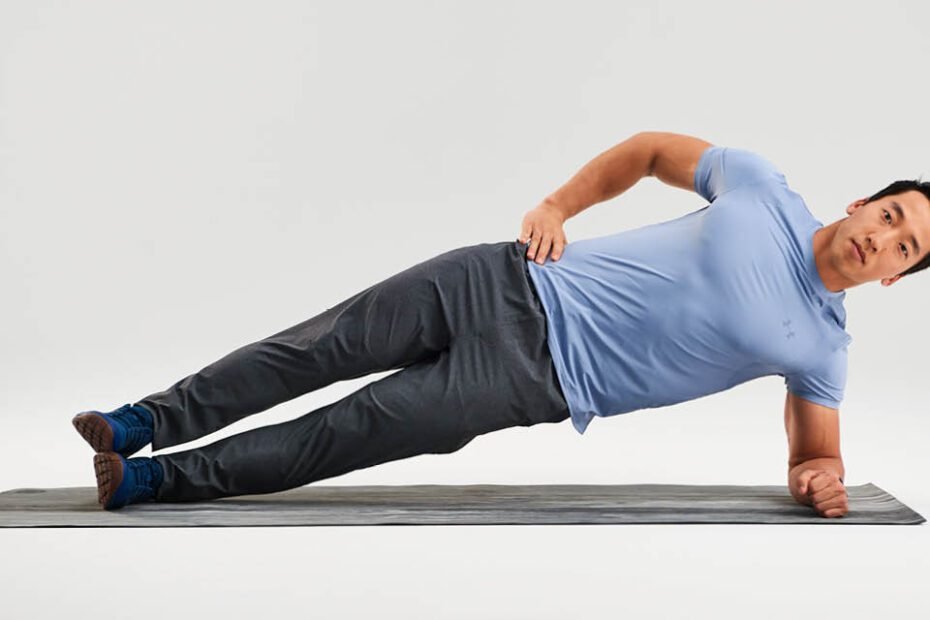The side plank is a highly effective core-strengthening exercise that targets your oblique muscles. In this comprehensive guide, we’ll explore how to perform the side plank correctly, the muscles worked, the benefits it offers, common mistakes to avoid, and a variety of variations and alternative core exercises to challenge your core even further.
Muscles Worked
Primary Muscle Targeted:
- Obliques (Muscles on the sides of your torso)
Secondary Muscles Engaged:
- Transverse Abdominis (Deep core stabilizing muscles)
- Erector Spinae (Muscles along the spine)
How to Perform the Side Plank Exercise
Follow these steps to perform a basic side plank correctly:
- Starting Position: Begin by lying on your side with your legs extended and feet stacked on top of each other.
- Elbow Position: Place your elbow directly below your shoulder, forming a 90-degree angle with your forearm. Your elbow should be aligned with your shoulder.
- Body Alignment: Lift your hips off the ground, creating a straight line from your head to your feet. Engage your core muscles to maintain stability.
- Head and Neck Position: Keep your head in a neutral position, aligning it with your spine. Avoid letting your head drop or looking up.
- Hold the Side Plank: Maintain this position for as long as you can while keeping proper form. Aim for at least 20-30 seconds as a starting point and gradually increase your time as you build strength.
- Breathe: Remember to breathe steadily throughout the exercise. Avoid holding your breath.
- Switch Sides: After completing the plank on one side, switch to the other side to ensure balanced muscle development.
Benefits of the Side Plank
The side plank offers a range of benefits for your fitness journey:
- Oblique Strengthening: The primary focus of the side plank is on your oblique muscles, helping tone and define your waistline.
- Core Stability: Engaging the obliques and transverse abdominis, the side plank enhances core stability, reducing the risk of back pain and improving posture.
- Muscle Balance: Including side planks in your routine helps balance abdominal muscle strength, reducing the risk of muscular imbalances.
- Functional Strength: A strong core contributes to better performance in daily activities and sports, enhancing overall functional strength.
- Spinal Support: The exercise engages the erector spinae muscles, providing support to your spine and promoting better posture.
Common Mistakes to Avoid
To maximize the effectiveness of your side plank and minimize the risk of injury, steer clear of these common mistakes:
- Drooping Hips: Keep your hips lifted and in line with your shoulders. Avoid letting your hips sag towards the ground.
- Overarching or Rounded Back: Maintain a straight line from your head to your feet. Avoid arching your back excessively or rounding your shoulders.
- Neglecting Proper Form: Focus on maintaining proper form rather than attempting a longer hold. Quality trumps duration.
- Holding Your Breath: Breathe steadily throughout the exercise to prevent muscle tension and fatigue.
Variations of the Side Plank
Once you have mastered the basic side plank, you can challenge your core further with these variations:
- Extended Arm Side Plank: Instead of resting on your forearm, support your body with a straight arm.
- Leg Lift Side Plank: Raise your top leg while maintaining the side plank position to engage your hip muscles.
- Side Plank with Rotation: Reach your top arm under your body and then up towards the ceiling, rotating your torso.
- Side Plank with Dips: Lower your hip towards the ground and then raise it back up, adding a dynamic element to the exercise.
- Side Plank with Knee Tucks: Bring your top knee towards your chest while maintaining the side plank position.
Alternative Core Exercises
If you’re looking to diversify your core workout, consider these alternative exercises:
- Plank: Engage your entire core by holding a plank position on your elbows and toes.
- Crunches: Target your upper and lower abdominal muscles with this classic core exercise.
- Russian Twists: Improve rotational strength and work your obliques with this seated twisting exercise.
- Leg Raises: Strengthen your lower abdominal muscles by lifting your legs while lying on your back.
- Bicycle Crunches: Work on both your rectus abdominis and obliques with this dynamic exercise that simulates pedaling a bicycle.
Incorporate side planks, variations, and alternative core exercises into your fitness routine to sculpt a strong and stable core, support your overall fitness goals, and enjoy the many benefits of a well-conditioned midsection.
